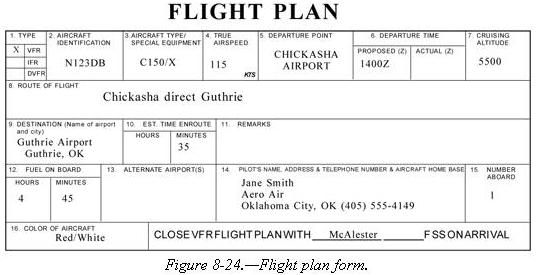
Filing a flight plan is not required by regulations; however, it is a good operating practice, since the information contained in the flight plan can be used in search and rescue in the event of an emergency.
Flight plans can be filed in the air by radio, but it is best
to file a flight plan either in person at the FSS or by phone just before
departing. After takeoff, contact the FSS by radio and give them the takeoff
time so the flight plan can be activated.
When a VFR flight plan is filed, it will be held by the FSS until
1 hour after the proposed departure time and then canceled unless: the
actual departure time is received; or a revised proposed departure time
is received; or at the time of filing, the FSS is informed that the proposed
departure time will be met, but actual time cannot be given because of
inadequate communication. The FSS specialist who accepts the flight plan
will not inform the pilot of this procedure, however.
| Figure 8-24 shows the flight plan form a pilot files with the Flight Service Station. When filing a flight plan by telephone or radio, give the information in the order of the numbered spaces. This enables the FSS specialist to copy the information more efficiently. Most of the spaces are either self-explanatory or nonapplicable to the VFR flight plan (such as item 13). However, some spaces may need explanation. |
 |
Item 10 asks for the estimated time en route. In the sample flight plan,
5 minutes was added to the total time to allow for the climb.
Item 12 asks for the fuel on board in hours and minutes. This
is determined by dividing the total usable fuel aboard in gallons by the
estimated rate of fuel consumption in gallons.
Remember, there is every advantage in filing a flight plan; but do not forget to close the flight plan on arrival. Do this by telephone with the nearest FSS, if possible, to avoid radio congestion. If there is no FSS near the point of landing, the flight plan may be closed by radio with the nearest FSS upon arrival at the destination airport.